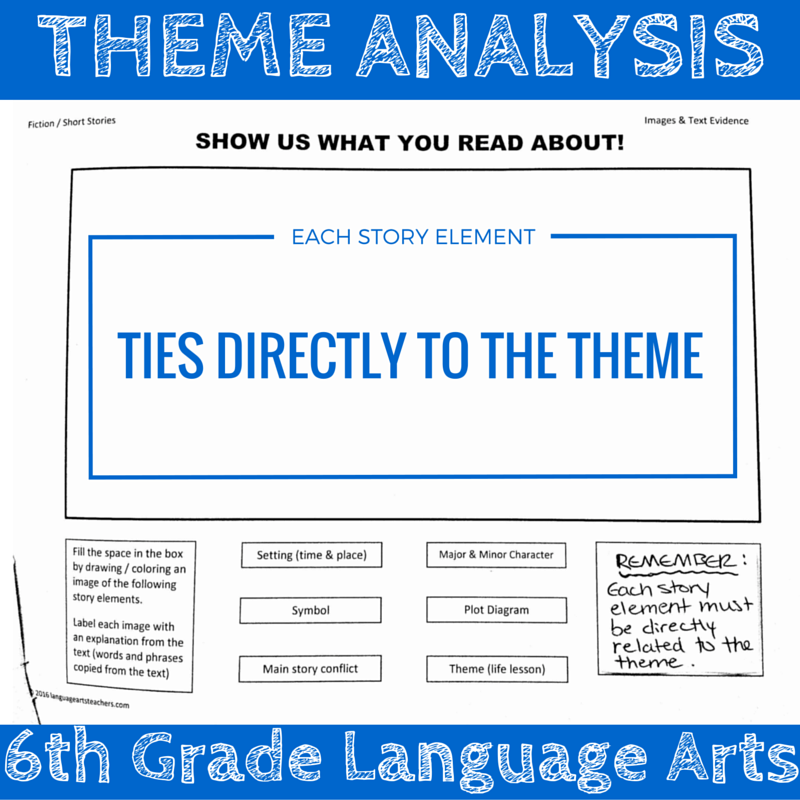Theme vs. Topic Activities
6th Grade Language Arts
Even though 6th graders have been learning how to identify the topic of their reading selections since pre-K, it gets all muddled when the teacher throws in theme and main idea, too.
Theme?
Topic?
Main idea?
They’re not all the same thing?
What? We can’t use those terms interchangeably?
So let’s focus on THEME here: Ways to teach theme (again!) as you move through the year.
The goal here is to help YOU- the TEACHER- introduce THEME, teach it, review it, come back to it, and have lots of activities and ideas for how to do this.
I’ll show you short, easy activities as well as longer, more advanced higher-level thinking and analysis activities.
Here we go!
ACTIVITY ONE
Make the concept of theme easily accessible to your kids.
In other words, introduce it and reteach it and spiral back to it using short passages of text that don’t take half the class to get through.
For instance, check out the little Aesop’s fables website for super quick, easy-to-read passages (audio is available for free on that website, too!). Use just one story a day or a week as a way to start or end class— Read together or in small groups, identify the topic, discuss the theme, maybe even write about it— done!
If you can do that consistently, then over time (sometimes a long time!) your students will be able to apply the “theme vs. topic” skill to all kinds of other things they read— novels, short stories, poems, plays, etc., so you’re constantly supporting the skill by doing this all throughout the year or the semester.
You can’t even talk about theme until your students have actually read the passage, so if you’re trying to teach and reteach and discuss and analyze the theme, how can you do that if you spent 30 of your 45 minutes in class just reading the text?
Sure, you can read one day and analyze the next day— there’s nothing wrong with that— but when the goal is to introduce, reteach, review, spiral back— then the whole point is to get it all done quickly and then to also do it frequently.
ACTIVITY TWO
Choose a short video (Aesop’s Fables, anyone?) to view, discuss, and write about theme vs. topic. Usually videos are so visually appealing that students can’t help but be drawn into the story. Plus, as long as technology is working well that day 🙂 it’s easy to set up with no copies to make and no papers to handle.
Check out these two Aesop’s fables videos (and there are so many more on YouTube, it’s not even funny!) that do a great job of quickly engaging kids in the story line so that together you can discuss the theme. The best part is that there are over 40 videos here and they’re mostly all under five minutes long. Nice, right??
(You could use one per week for the entire school year to constantly reinforce and practice those topic / theme / main idea skills.)
ACTIVITY THREE
Discussion is great, especially when it’s student-lead and engagement is high, but there are times when the kids just can’t handle it (and you can’t either— we’re realistic around here!)
For instance, the last class of the day on Friday before a three day weekend… That may not result in exactly the highest level of analytical discussion for your students!
That being said, it’s ok to have students write about theme or fill in a graphic organizer about it. In fact, let’s say you’re actually sick that day— oh, you’re there in the classroom because it was too late to get a sub—but you’re throat hurts and your head is pounding and
you
Just.
Can’t.
Do.
It.
Tell your students that they’re going to have a “video quiz” today!
What? A video quiz?
Yes! A video quiz!
So… they have to watch the video you put on (an Aesop fable video of course) and they have to watch it quietly.
Cuz… Ya know… It’s a quiz and all.
And then give them a little follow-up assignment to complete after it (you can even get away with showing them the same video 2-3 times here because if you want them to use text evidence to support the theme they see in the video, then they’ll need to see it more than once.
You can create a quick little handout like this, or just sketch it out quickly on the board and have the kids copy it down and fill in the information themselves. View one video per week or one video per day and have students turn in the form after having completed four at a time (easy to grade!).
ACTIVITY FOUR (ADVANCED)
For a longer piece of text, like a short story that’s longer than a page or even for a culminating piece in a novel, consider an assignment that could actually be an overall assessment that links the theme to many other facets of the story, like in this assignment:





